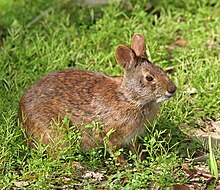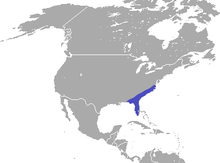Marsh rabbit
| Marsh rabbit | |
|---|---|
 |
|
| Scientific classification | |
| Kingdom: | Animalia |
| Phylum: | Chordata |
| Class: | Mammalia |
| Order: | Lagomorpha |
| Family: | Leporidae |
| Genus: | Sylvilagus |
| Species: | S. palustris |
| Binomial name | |
|
Sylvilagus palustris (Bachman, 1837) |
|
| Subspecies | |
|
S. p. palustris |
|
 |
|
| Marsh rabbit range | |
S. p. palustris
S. p. paludicola
S. p. hefneri
The marsh rabbit (Sylvilagus palustris) is a small cottontail rabbit found in marshes and swamps of coastal regions of the Eastern and Southern United States. It is a strong swimmer and found only near regions of water. It is similar in appearance to the eastern cottontail (Sylvilagus floridanus) but is characterized by smaller ears, legs, and tail.
The scientific name Sylvilagus palustris derives from a combination of the Latin words silva (forest), lagos (hare), and palustris (of the marsh). The marsh rabbit has commonly been associated with the group of swamp rabbits; however, this name is not a synonym and should not be confused with the larger swamp rabbit (Sylvilagus aquaticus) of Alabama through Texas. They have also often been referred to as marsh hares.
Marsh rabbits are typically smaller than eastern cottontail rabbits. Adults from the Florida peninsula typically weight around 2.2 - 2.6 lbs (1.0 - 1.2 kg) with a total length up to 17 in (43 cm). Adults from the mainland regions typically grow larger up to 3.5 lbs (1.6 kg) and upwards of 17.5 in (44 cm). The hind feet of mainland rabbits are also larger at 3.6 in (9.4 cm) compared with 3.5 in (8.9 cm) of peninsular Florida rabbits.
Marsh rabbits display a blackish brown or dark reddish dorsal surface. The belly is a dingy brownish gray in most but can also have a dull white appearance in mainland rabbits. The leading edges of the ears display small black tufts with ochre on the inside. rough hair on the dorsal side can be fringed with black hairs. The black portions of the upper parts often change to a dull grayish buff in spring and summer months, returning to a reddish or ochre color in fall, followed by darker black in the winter. Rabbits of peninsular Florida typically display darker and redder colors with a cinnamon-rufous nape, feet, and legs. Juveniles display much darker and duller colors than adults.
One feature that distinguishes marsh rabbits from swamp rabbits and cottontails is that the underside of the tail is almost never white but more brownish gray. Another curious feature observed in specimens from southern Florida is melanism. These individuals exhibit completely black phenotypic coloration that does not change seasonally.
Marsh rabbits have a number of features that distinguish them from cottontails and swamp rabbits. The short ears and legs are much smaller than that of a swamp rabbit. The tail is also much reduced from the bushy tail seen in cottontails.
...
Wikipedia

